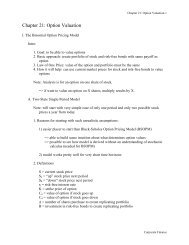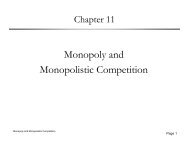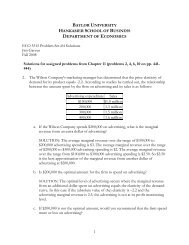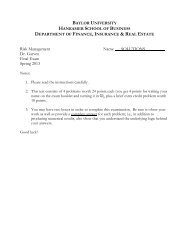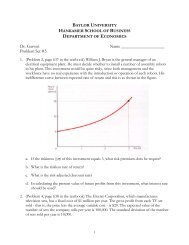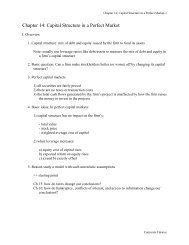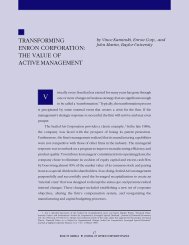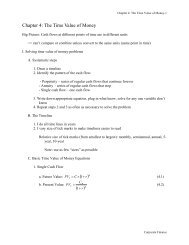Insurance Company Capital Structure Swaps and Shareholder Wealth
Insurance Company Capital Structure Swaps and Shareholder Wealth
Insurance Company Capital Structure Swaps and Shareholder Wealth
You also want an ePaper? Increase the reach of your titles
YUMPU automatically turns print PDFs into web optimized ePapers that Google loves.
Wt=2 = EM,t=0<br />
Et=2<br />
EM,t=1<br />
Where Wt=2 is the shareholder wealth at t = 2 <strong>and</strong> Ejt is the j value of equity at time t. Equation<br />
12 represents the proportion of total equity market value before the swap (held by the controlling<br />
shareholders) to total equity market value after the swap (held by both controlling shareholders<br />
<strong>and</strong> noise traders). Thus the ratio reflects the smaller proportion of total equity market value held<br />
by the controlling shareholders after the swap has occurred. This ratio is then multiplied by the<br />
total t = 2 equity value to represent the terminal wealth of the controlling shareholders. New<br />
shareholders have been added, <strong>and</strong> the controlling shareholders now hold a smaller portion of the<br />
total equity than they held before the swap occurred. Managers will engage in the swap only when<br />
the optimal t = 2 wealth exceeds the t = 0 wealth.<br />
When the firm issues new policies <strong>and</strong> uses the proceeds to retire equity, the initial wealth of<br />
controlling shareholders is the ratio of market value of equity at t = 2 to the market value of equity<br />
at t = 0, multiplied by the t = 0 insider value of the firm’s equity:<br />
Wt=0 = EM,t=1<br />
EI,t=0<br />
EM,t=0<br />
Equation 13 represents the proportion of total equity market value after the swap to total equity<br />
market value held before the swap, <strong>and</strong> reflects the ratio of total equity held by the controlling<br />
shareholders. This ratio is then multiplied by the total t = 0 insider equity value to represent the<br />
wealth of the controlling shareholders prior to the swap. The controlling shareholders hold a larger<br />
portion of the equity after the swap than they held before the swap occurred. Again, managers<br />
will engage in the swap only when the the t = 2 wealth exceeds the t = 0 wealth.<br />
For firms issuing equity <strong>and</strong> using proceeds to purchase reinsurance, the change in controlling<br />
shareholder wealth as a function of expected losses is:<br />
17<br />
(12)<br />
(13)



